All the World’s a Hybrid Cloud—Or Is It?
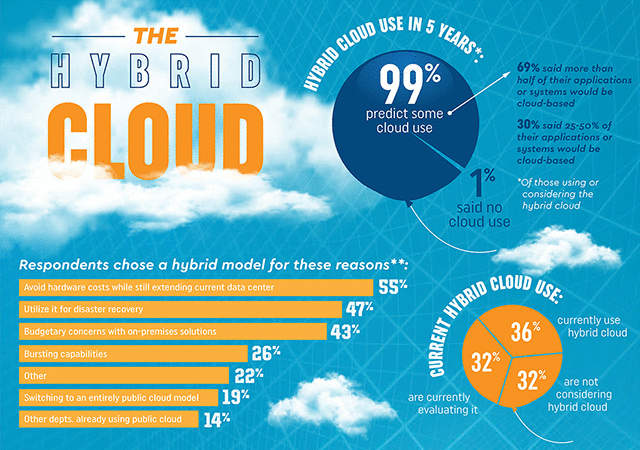
How many will join the hybrid cloud side?
Enterprise IT, it turns out, is complicated.
This should be good news for anyone who makes a living in this space. It should also continue to be the case, as a frenetic move toward all things IoT and nascent interests in blockchain technologies create new layers within modern enterprise IT fabrics.
A center of discussion within this context is the idea of a hybrid cloud, a term that has been around for many years, but which is being redefined by technology providers and their customers. Some of these discussions imply that 80% of enterprise IT shops will “commit” to hybrid cloud strategies by next year, according to a Futurescope prediction from IDC. Similar results showed a research by RightScale in 2016.
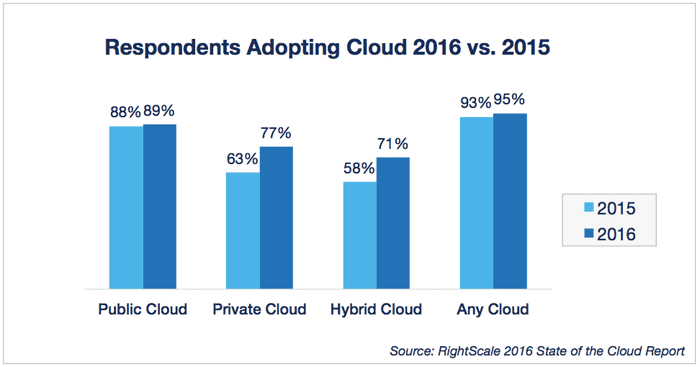 Source: RightScale
Source: RightScaleCommitting in the sense of assent isn’t the same thing as committing in the sense of coding, so there’s not an implication here that 80% of enterprise IT will be on or in a cloud that quickly. However, this is an astonishing statement.
Another Futurescope prediction is that “by 2018, 65% of firms’ IT assets will be off-site in colocation hosting and cloud data centers, while one-third of IT staff will be those of third-party service providers.”
“There is an enormous opportunity for hosting companies to sharpen their act.”
This implies an enormous opportunity for hosting companies and colocated data centers to sharpen their act and grab a lot of new business. Indeed, opportunities for cloud service providers (here comes the CSP acronym, ready or not) was a central focus of the recent IBM Edge conference in Las Vegas and the DCD Converged conference in Dallas.
Is all the world a hybrid?
So, it may seem easy enough to say that all cloud strategies today are hybrid cloud strategies, but it would also be wrong to say this. Altoros, for example, can point to one major migration to a pure, “all in” commitment to public-cloud gorilla Amazon Web Services (AWS).
Other essential examples of this genre include Netflix (which continues to grab an enormous share of all the US bandwidth during evening hours), Spotify, Reddit, and not to be forgotten, Amazon itself (one of the top 10 busiest websites in the world). It will be fascinating to see if and when major enterprises go all in with Azure or Google in the coming months and years.
Is cloud a utility?
There’s never a bad time to cite Nic Carr’s book, The Big Switch, which is now almost nine years old and which said compute resources will some day be thought of as electricity or water. Just as early Industrial Age factories had their own power plants and water supplies, today’s early Cloud Computing Era enterprises still have their own data centers.
Will there be a time when data is just another utility?
My view is that we’re far from reaching Nic’s vision: compute has many more elements than water or electricity, it doesn’t reach consumers in the same way as traditional utilities, and the notion of a data center itself should be evolving rapidly.
Furthermore, electricity and water can be stolen, but at only their tangible value. We’re already in the midst of an era in which stolen data has enormous intangible value, enough to bring down companies and change governments. Will there ever be a time when all that data is just another utility?
A couple of examples
Thinking about data and data centers as utilities, let’s imagine an IoT deployment that’s part of a Smart City initiative to measure traffic. Sensors are scattered over a large area, with latency issues emerging if they are all routing traffic back and forth to a central data center. Why not have a small “data center in a box” located near each cluster of sensors? Data centers will some day be held in the palm of our hand, or even embedded on a chip. Must these data centers be owned by large utility companies?
In a different sort of IoT, the Industrial Internet deployments associated today (as an example) with GE’s jet engines and trains and the company’s Cloud Foundry-based Predix software are starting to generate entire realms of new data. The amount of data handled by data centers now runs to several zettabytes (i.e., several million petabytes) per year and is doubling in every three years or less.
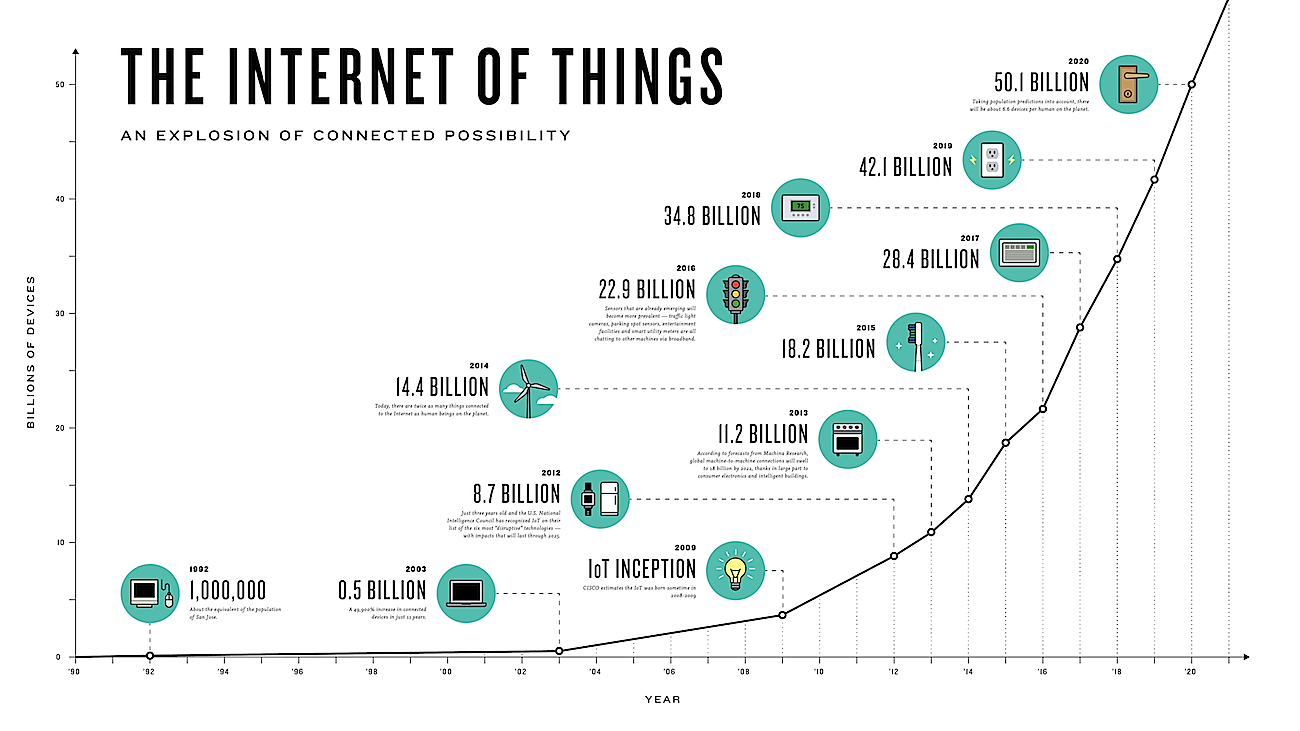 Source: i-SCOOP
Source: i-SCOOPSo, the IoT is a megatrend, and it is not going away. On the hypothesis that not all analysts can be completely wrong, I present here a fascinating curation of IoT predictions, all calling for aggressive growth (some with CAGR’s upwards of 40% per year), tens of billions of sensors, and hundreds of billions in annual revenue.
Given that worldwide enterprise IT spend has been flattish at around $2 trillion for the past few years, in large measure due to increased efficiencies and downward price pressure on technology, it’s hard to see how these hundreds of billions would not simply cannibalize current expenditures. I’ll have more thoughts on this topic in an upcoming post.
The IoT is a megatrend, and it’s not going away.
Cloud complexity to continue
Due to the continued complexity of enterprise IT challenges and the accelerating growth of data, hybrid cloud appears to be entering a new era of acceptance by the majority of large enterprises.
Technology vendors are reflecting this notion. Oracle just announced a bellicose new effort to grab cloud market share while retaining its long locked-in customers. VMware, the pioneer of private cloud, just reached across the aisle to forge a new hybrid alliance with AWS.
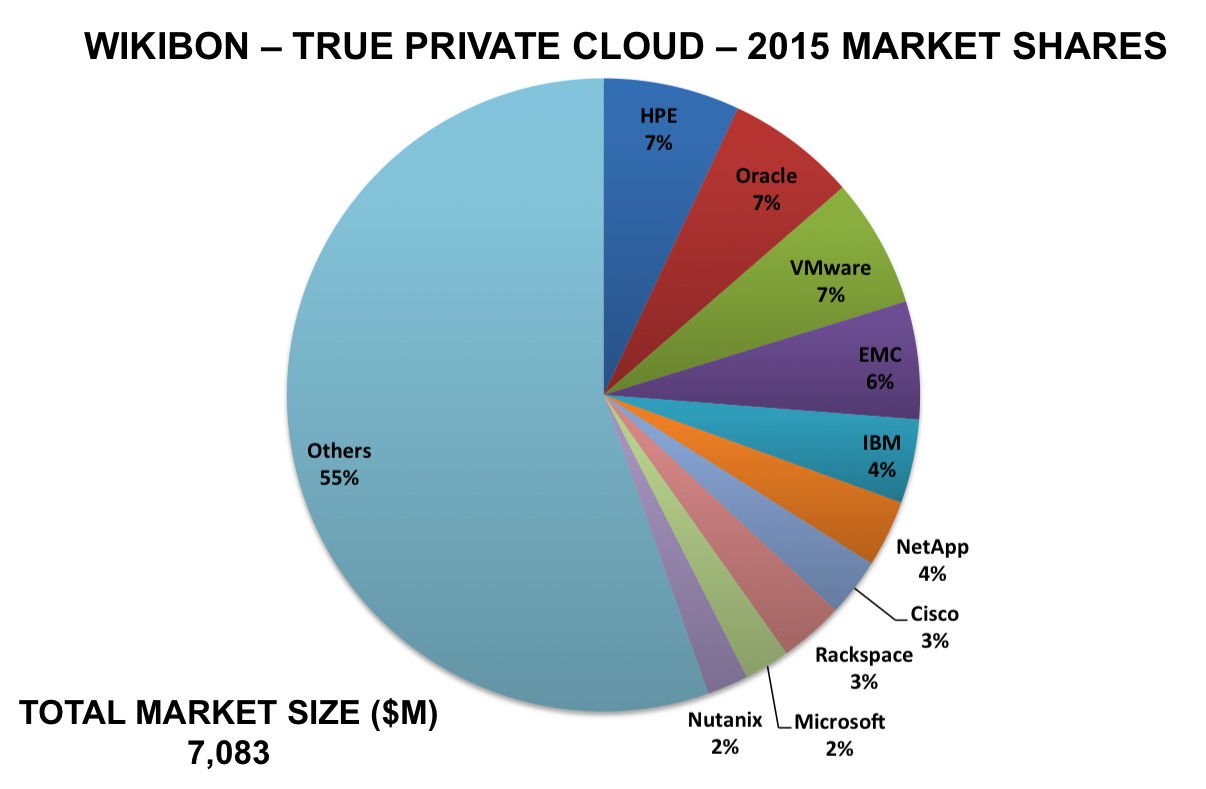 Source: Wikibon
Source: WikibonMicrosoft continues to push its one-stop shop Azure hybrid. HPE and SAP continue to leverage Cloud Foundry (Helion and HANA) to do…something. And IBM has committed to a hybrid vision, pounding that point home to several thousand customers at its recent Edge event in Las Vegas.
Looking for an easy button
Hybrid thinking follows classic enterprise IT thinking of constructing a whole from disparate pats. Whether an earlier generation’s “best of breed” or today’s “ecosystems,” even the most dedicated adherents to vendor lock-in are not doing it completely alone.
There is a historical precedent: One of the big lies technology vendors told in the 90s was that of “seamless interoperability,” the notion that your data would magically flow from one application or environment to another. As the customers found out from experience not to believe the lie, a multi-billion dollar industry of middleware prospered.
Interoperability dreams continue today, as IT managers attempt to keep the water flowing in all pipes and in all directions. The use of APIs facilitates this and it doesn’t seem to be an exaggeration to describe the IT-driven sectors of the global economy as an “API economy.”
Add mobility…
As ubiquitous mobile devices have begotten sensors in a burgeoning IoT, the protocols and techniques of interoperability assume more importance. This is reflected, I think, in the recent announcement of the Allseen/OCF merger. These two organizations, founded respectively in 2013 and this year, both hack at that critical mobile/remote interoperability problem.
It’s all open-source(ish) stuff.
The Allseen Alliance was built to foster work done by Qualcomm, whereas the Open Connectivity Foundation (OCF) was founded with the original name of Open Interconnect Consortium (OIC) by Intel, Broadcom, and Samsung. The merger relegates the Allseen name to the dustbin of history, for better or worse, with the combined organization being operated by the (increasingly powerful) Linux Foundation, as a collaborative project.
It’s all open-source(ish) stuff, with the notion to develop a universal solvent for interoperability at every stage of IoT deployments—what they have in mind is breakfast in bed for 25 billion devices, to paraphrase the great Wavy Gravy (a.k.a Hugh Romney).
The original term holds up well!
Returning to a hybrid cloud, we can remember that this term was originally defined in 2011 by the US National Institute of Standards and Technology (NIST) as “a composition of two or more distinct cloud infrastructures (private, community, or public) that remain unique entities, but are bound together by standardized or proprietary technology that enables data and application portability (e.g., cloud bursting for load balancing between clouds).”
The definition seems to have held up quite well, even as portability (tightly related if not quite the same thing as interoperability) remains a rainbow to be chased and consistent cloud-bursting infrastructures may end up being unicorns.
The key questions regarding a hybrid cloud are “why” and “what”?
Are IT execs testing an eventual migration to an all-public infrastructure?
Why do IT execs and managers want to build hybrid clouds? Do they make an inference from C-suite chatter that a hybrid cloud is a safe, hedged way to create the best of all worlds? Do they come to this conclusion from their own analysis? Do they want to use the public cloud instances for POCs, prototypes, small pilots, etc.? Are they testing an eventual migration to an all-public infrastructure?
What do they seek? Archival breathing room? Flexible capacity when they need it (i.e., the bursting phenomenon)? Specific apps and services (whether an internal evergreen like HR benefits or a customer-facing service like reward programs or notifications)?
Does cloud create jobs or not?
In the late fall of 2009, I was horrified to hear a C-level exec from a major technology provider proclaim he had replaced two entire floors of IT professionals “with three guys from India.” The disquieting ethnic overtones of that remark were exceeded only by the remark’s callousness, and ultimately, inaccuracy.
Worse for me, this guy was a keynote speaker at an event I chaired. I had been briefed that he was going to talk generally about transforming enterprises with cloud computing, an evergreen topic even then. I wasn’t aware of and didn’t foresee his specific viewpoint.
Fortunately for all concerned, he was gone from that tech company within a few months and no longer plays a major role in the industry. That company also has no existing cloud strategy as far as I can see, so shall remain nameless.
In the intervening years, innumerable enterprises have experienced the benefits of using public-cloud services. One could without doubt research how the use of a public cloud has stifled IT job growth within the specific departments of the specific companies that use AWS and its competitors.
Growth, growth, and growth
However, we could also find job growth at Amazon and its competitors, as well as job growth that can be attributed to whatever bright ideas came to fruition from all of those public-cloud instance deployments. How many new products and services were possible only because they got their start from public-cloud instances on a laptop, something for which there is no comparable option within a company’s on-site infrastructure?
Amazon had a 32% share of public cloud in Q1 2016
According to Synergy Research Group, Amazon had a 32% market share of public cloud in Q1 2016, with 57% year-on-year growth. The next three providers combined (Microsoft, IBM, and Google) collectively grabbed 22%, albeit with almost a doubling in revenue growth.
A third group of 20 companies grabbed 27% (with growth of 41%), this group including Alibaba, CenturyLink, Fujitsu, HPE, NTT, Oracle, Orange, Rackspace, Salesforce, and VMware.
A few notes are in order with respect to this group:
- HPE stopped providing public cloud earlier this year, as we all know.
- As also noted elsewhere in this article, Oracle recently announced a new and aggressive effort to gain public-cloud business.
- VMware’s reaching out to AWS seems to beg the question of it continuing as a public-cloud provider.
The Synergy research also attributes 19% of the public-cloud market to unnamed others, with this group showing a lagging 30% growth.
Research from Wikibon shows a similar pattern:
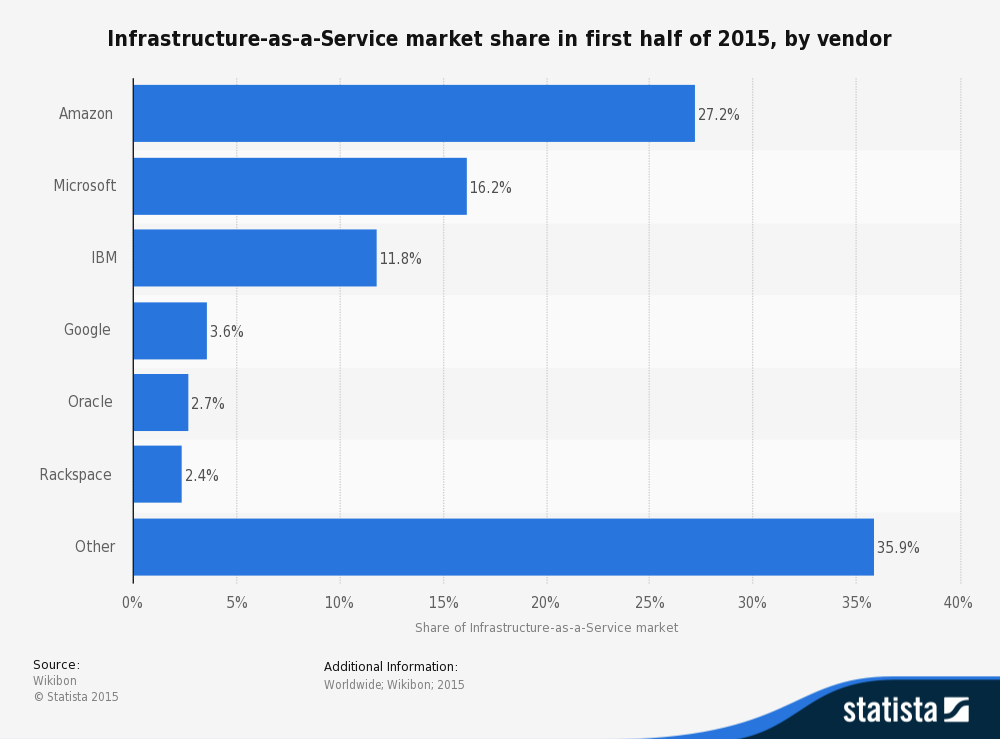 Source: Statista
Source: StatistaStill, within this context, IBM now looks at hybrid as involving possible combinations of on-premises IT (whether cloudy or not), off-site hosted and/or colocated cloud, and public cloud from AWS, Microsoft Azure, and/or other providers, while seeming to keep its Cloud Foundry-based Bluemix in the middle of things. I suspect the other big vendors do as well.
Yes, it’s complicated. Once we accept that, we can focus on hiring (enough of) the right people in our organizations and finding the tools from the vast toolbox available today that best meet our immediate needs and future vision.







